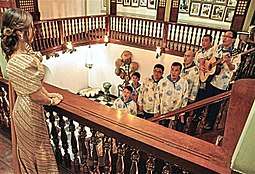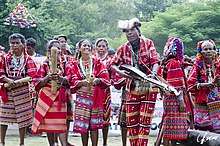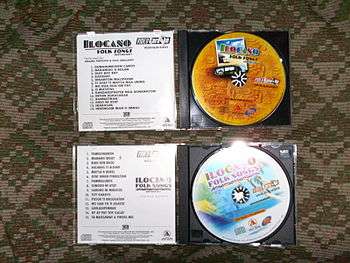Philippine folk music
The traditional music of the Philippines, like the folk music of other countries, reflects the life of common, mostly rural Filipinos. Like their counterparts in Asia, many traditional songs from the Philippines have a strong connection with nature. However, much of it employs the diatonic scale rather than the "more Asian" pentatonic scale, with the exception of indigenous people ritual music.

| Philippine folk music | |
|---|---|
| Stylistic origins | Folk music |
| Cultural origins | Individual ethnic groups in the Philippines |
| Typical instruments | |
| Derivative forms |
|
| Other topics | |
| OPM | |
Classification
Traditional Filipino music is reflective of the country's history as a melting pot of different cultures. Among the dominant cultural strains noticeable today are Hispanic, American and to some extent Chinese, Indian and Islamic. It is thus difficult to strictly classify the whole corpus of Philippine music as either western or eastern.
A frequently used system is to classify it according to ethno-linguistic or cultural divisions: for example, traditional Tagalog music, which is somewhat more Hispanic in flavour, differs from Ifugao music and Maranao kulintang music.
Vocal music
A commonality is that vocal music is of significant import to every ethnic group in the country. Although there is some music intended for dance, the best-preserved form of traditional music is that intended for the voice, with chanting epic poetry as having been the earliest form and later augmented by instrumental accompaniment. Regarded to have a wide range, as most of them stretch more than an octave, they are still considered within the capacity of even an average singer.
Linguistics of traditional music
Borromeo also noted that one interesting feature of Western-influenced traditional music is that a tune is not bound to a particular language or dialect.
Many songs in the different Philippine languages, however, share the same tune, such as the Tagalog Magtanim ay 'Di Biro, Kapampangan Deting Tanaman Pale and the Gaddang So Payao. Another example is the Visayan song Ako Ining Kailu, which has the same melody as the Ibanag Melogo y Aya and Kapampangan Ing Manai.

The largest body of songs are those using the various vernacular languages, especially the eight major languages in the country. Many of the collected traditional songs have a translation in Filipino, the national language, but most scholars tend to ignore its existence.
Songs from the various minority languages rank second in recognition, while those in Spanish rank third. This does not include the closest local language to Spanish, called Chavacano, which has a degree of mutual intelligibility with Castilian. The most famous songs in this classification are perhaps No Te Vayas de Zamboanga and Viva! Señor Sto. Niño.
Dance music
After vocal music, dance music is the next most important form of traditional Philippine music. As mentioned above, the best form of preserved music are those with lyrics, and this is also true for music intended to accompany a dance. According to Francisca Reyes-Aquino, known for her voluminous collection of folk dances, people watching the dance sing the songs in the same way that cheerers chant in a game. This is very evident especially in songs where interjections Ay!, Aruy-Aruy!, Uy! and Hmp! are present, such as Paru-parong Bukid.
Music falling under this category may be classified as those belonging to Christianised Groups, Muslim Groups, and the other Ethnic Groups.
Christianised groups
As Christianity was introduced to the Philippines, Dance Music classified as belonging to the Christianised Groups are somewhat related to Western music as well. Dance Music falling under this category may also be called Habanera, Jota, Fandango, Polka, Curacha, etc. and has the same characteristics as each namesakes in the Western Hemisphere.
However, there are also indigenous forms like the Balitao, Tinikling and Cariñosa (the national dance). In a study by National Artist for Music Dr. Antonio Molina, the Balitao, famous in Tagalog and Visayan regions, employs a 3/4 time signature with a "crotchet-quaver-quaver-crotchet" beat. Others use the "crotchet-minim" scheme, while others use the "dotted quaver-semiquaver-crotchet-quaver-quaver" scheme.
This type of music is generally recreational and, like traditional music from the West, is used for socialising.
Southern groups
The court and folk dance music of the Muslim-Filipino groups have somewhat preserved ancient Southeast Asian musical instruments, modes and repertoires lost to Hispanicised islands further north. It is important to note that stricter interpretations of Islam do not condone musical entertainment, and thus the musical genres among the Muslimised Filipinos cannot be considered "Islamic".

Genres shares characteristics with other Southeast-Asian court and folk music: Indonesian Gamelan, Thai Piphat, Malay Caklempong, Okinawan Min'yō and to a lesser extent, through cultural transference through the rest of Southeast Asia, is comparable even to the music of the remote Indian Sub-Continent.
Generally, music falling under this category tells a story. An example is the Singkil, which relates an episode from the Darangen (the Maranao version of the ancient Indian epic, the Ramayana). The dance recounts the story of Putri Gandingan (Sita) as she was saved by Rajahmuda Bantugan (Rama) from crashing rocks, represented by bamboo poles. The Singkil is considered the most famous in the Philippines under this category for its perceived elegance, and is also performed by Filipinos from other ethnic groups throughout the country.
Music is related in war in some regions in the country, as it is a way to show the emotions of victory and defeat, as well as the resolution of conflict. Philippine music also depends on the biographical factors: in cooler regions such as the Cordilleras, the beat of the music is so slower, while in warmer areas it is quite fast.
Indigenous groups

Like secular songs from the same group, this form of music has a sort of beat, even though it is hard to put it in a form of time signature. Percussions are mainly used for these type of music and sometimes, a gong is enough.
As closeness to Nature is a main feature of these ethnic groups, one can expect that dance steps falling under this category are a mimicry of the movements of plants and animals of a certain locality. Some music is simply called the 'Monkey Dance' or the 'Robin Dance' for identification.
Some of the music falling under this category is ritual music: thus there are dances used for marriage, worship, and even preparation for a war.
Popularity

Unlike folk music in Ireland, Hungary, the Czech Republic and neighbouring Malaysia, traditional music in the Philippines has never reached contemporary popularity. Perhaps, it is partly due to the fact every region of the Philippines has its own language, and several decades of Americanisation.
Though some groups tried to collect songs from the different ethnolinguistic groups, none has so far succeeded in making traditional music a part of the national identity, much more a national symbol. It is rarely taught in Elementary school, as in Ireland, aside from Children's songs. This results in a mentality that traditional songs are children's songs.
The decline was accelerated with the entry of television, making popular culture from Europe and the United States easily accessible to a common Filipino. Though most Europeans would say that Filipinos are music-loving people, traditional music is always at risk of being left in oblivion.
Attempts have been made to collect and preserve Traditional Philippine Music but most of them focus only on the Vocal form. Under centuries of Spanish colonization of the Philippines, no collection of the traditional music was ever made. There are however studies made regarding this subject in the late 19th century, when the Romanticists of Europe began to find the value of folk songs.
Even during the American Era, attempts to collect traditional music came rather late. Perhaps the first collection was in 1919 by Fr. Morice Vanoverberg, which is focused on the traditional music of the Lepanto Igorots of the north. Unfortunately, only the words and not the tunes are included in the collection.
The collection entitled 'Filipino Folk Songs' by Emilia Cavan is considered to be the earliest collection with tunes, published in 1924. Perhaps, the most important collection of Folk Songs is the 'Philippine Progressive Music Series' by Norberto Romualdez published in the late 1920s.
Unfortunately, the collectors who worked with Romualdez did not present the songs in their original languages but rather translated them into English and Filipino. This collection also included some songs aimed to promote National Identity, like the National Anthem of the Philippines, Philippines Our Native Land and even Philippines the Beautiful (an adaptation of America the Beautiful). The collection also included some folk songs from other countries.
For a period of time, Romualdez's collection became the textbook for teaching music in the Primary School. It also ensured that folk tunes from every part of the country is preserved and will be passed to the next generation of Filipinos. Until now, this collection remains to be the most important collection of traditional music from the Philippines, since a copy of it is still available in major Municipal and Provincial Libraries in the country.
Other collections like the 'Filipino Folk Songs' by Emilia Reysio-Cruz caters to the so- called 'Eight Major Languages' of the country and according to some, the collection is the best representation of the songs from these ethnolinguistic groups.
Dr. Jose Maceda, former chair of the Department of Asian Music Research of the College of Music of the University of the Philippines, also did some collection which began in 1953 and lasted until 1972. This was followed by collections from his students as well.
During the last years of the 20th century until the early 21st century, Raul Sunico, Dean of the Conservatory of Music of the University of Santo Tomas, published his own collection. He began with publishing a collection of lullabies, followed by love songs, then by work songs. Finally, he published a collection of songs about Filipino women, a major topic of traditional songs from all the ethnolinguistic groups. All these collections were arranged for the piano and the words are given in their original languages. A translation is also supplied, not to mention a brief backgrounder about the culture of the specific ethnic groups.
Forms
It has the:
- Strophic/unitary form
- Binary form
- Ternary form
- Rondo form
With regard to traditional dance music, the seven volume collection of Francisca Reyes-Aquino is still the most important collection. None has yet followed her lead until now.
Commercial use
Some Philippine rock icons from the 1970s tried to record folk songs. Florante, Freddie Aguilar, Heber Bartolome, Joey Ayala and the group Asin propagated Filipino folk songs akin to the phenomenon in the United States.
Many serious musicians have also recorded folk songs but none yet have made a folk song so successful that it would penetrate the commercial charts. Nowadays, popular musicians tend to overlook this genre. Its continuity is now deferred mostly to musicians in the academic sphere.
References
- Philippine Literature: Folk Music by Mauricia Borromeo
- Philippine Progressive Music Series by Norberto Romualdez.
- The Encyclopedia of Philippine Art, Volume 6: Philippine Music by the Cultural Centre of the Philippines
- Himig: A Collection of Traditional Songs from the Philippines by Raul Sunico
- Filipino Folk Songs
